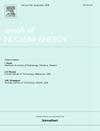Cluster-dynamics study on the evolution of dislocation loops in molybdenum: The role of defect diffusion coefficient and equilibrium concentration
IF 1.9
3区 工程技术
Q1 NUCLEAR SCIENCE & TECHNOLOGY
引用次数: 0
Abstract
A cluster dynamics simulation based on rate theory was conducted to investigate the evolution of irradiation-induced dislocation loops in pure molybdenum () irradiated with + at . The changes in number density and size of dislocation loops were analyzed, revealing rapid saturation of loop density with increasing dose, while the average loop radius grows and stabilizes at a maximum size. During the initial irradiation stage, significant nucleation leads to a rapid increase in loop density. The simulation results align well with in-situ transmission electron microscopy observations and clarify the kinetic mechanisms underlying key experimental features. It was found that the diffusion coefficients and thermal equilibrium concentrations of interstitial atoms and vacancies play critical roles in determining the evolution of loop density and size at elevated temperatures. This study provides insight into the microstructural evolution of irradiated molybdenum under helium ion exposure.
钼中位错环演化的团簇动力学研究:缺陷扩散系数和平衡浓度的作用
基于速率理论的团簇动力学模拟研究了30keV He+辐照673K时纯钼(Mo)中辐照诱导位错环的演化。分析了位错环数密度和大小的变化,发现随着剂量的增加,位错环密度迅速饱和,而平均位错环半径增长并稳定在最大值。在初始辐照阶段,明显的成核导致环密度迅速增加。模拟结果与原位透射电镜观察结果吻合良好,阐明了关键实验特征背后的动力学机制。研究发现,扩散系数、间隙原子和空位的热平衡浓度是决定环密度和尺寸在高温下演变的关键因素。本研究对辐照钼在氦离子照射下的微观结构演化提供了新的认识。
本文章由计算机程序翻译,如有差异,请以英文原文为准。
求助全文
约1分钟内获得全文
求助全文
来源期刊

Annals of Nuclear Energy
工程技术-核科学技术
CiteScore
4.30
自引率
21.10%
发文量
632
审稿时长
7.3 months
期刊介绍:
Annals of Nuclear Energy provides an international medium for the communication of original research, ideas and developments in all areas of the field of nuclear energy science and technology. Its scope embraces nuclear fuel reserves, fuel cycles and cost, materials, processing, system and component technology (fission only), design and optimization, direct conversion of nuclear energy sources, environmental control, reactor physics, heat transfer and fluid dynamics, structural analysis, fuel management, future developments, nuclear fuel and safety, nuclear aerosol, neutron physics, computer technology (both software and hardware), risk assessment, radioactive waste disposal and reactor thermal hydraulics. Papers submitted to Annals need to demonstrate a clear link to nuclear power generation/nuclear engineering. Papers which deal with pure nuclear physics, pure health physics, imaging, or attenuation and shielding properties of concretes and various geological materials are not within the scope of the journal. Also, papers that deal with policy or economics are not within the scope of the journal.
 求助内容:
求助内容: 应助结果提醒方式:
应助结果提醒方式:


